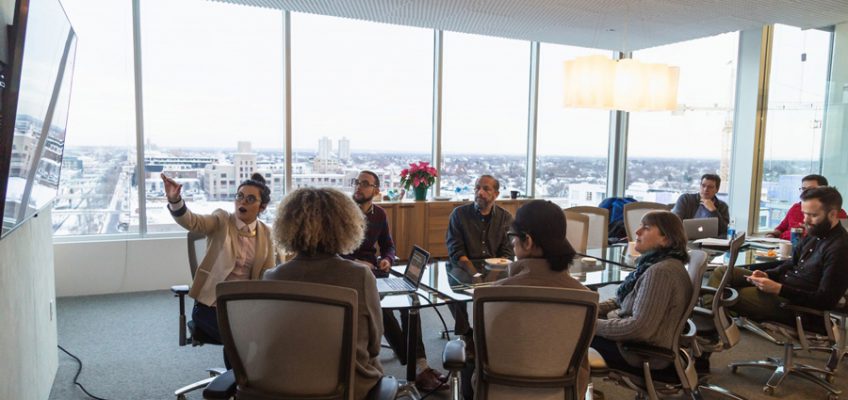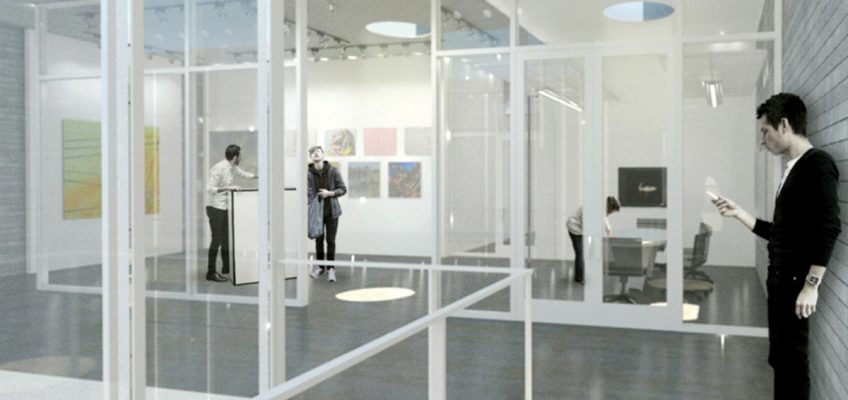by Rita Kovtun
With a new director and faculty members, a reinvigorated curriculum and a dedicated collaborative space buildout, updates to Minneapolis College of Art and Design’s entrepreneurial studies (ES) program respond to the needs of today’s students and economic landscape, keeping MCAD and this twenty-year-old program on the cutting edge.
The program began two decades ago with first director Lester Shen, originally accredited as a visualization program and MCAD’s only bachelor of science degree that focused on interdisciplinary thinking, process and computer technology. Jerry Allan took over in 2008, integrating advertising into the program and establishing a solid foundation for ES through the creation of a mission: giving students the opportunity to make connections between business, art, design and science, while collaborating on teams with real clients on real projects locally, nationally and globally.
In today’s “gig” economy, students expect to work as freelancers or move jobs every three to five years and to constantly be retraining on new methods and technology. Although ES has always equipped students with general skills and ways of thinking that are transferable from job to job, the program intentionally remains responsive to the constantly changing dynamics of the tools, methods and practices of the evolving economy. Today’s students also demand more. Research shows that millennials are conscientious consumers who seek to make a difference and want to find fulfillment in their work.
Leading the program in response to these developments is new director Stephen Rueff, who previously worked in the fields of corporate marketing, communications and performing arts. With his belief in the power of business to create change, Rueff’s personal mission is to guide students in defining their dreams and setting them on the path to realizing their potential while shaping profitable, equitable, and environmentally sound business models.
Under Allan’s leadership, students in the ES program worked on five-year projects, building upon the research of those who came before them to deliver implementable projects for clients like One Million Books for Gambia, Edremit Wetland Conservation in Turkey, International Health Service of Minnesota in Honduras and Pillsbury United Communities’ North Market in Minneapolis. These projects helped MCAD students learn to work collaboratively, think critically, complement their art and design skills with business training, and launch their careers as entrepreneurs, creative directors, user experience leaders, project managers and more. Truly, this has always been a program where creativity meets purpose as artists and designers focus their talents on creating positive change.
Rueff will carry forward the mission of the program, introducing a shift toward the broader concept of sustainable development, while ensuring students are introduced to concepts and practices used in today’s creative economy. In reinvigorating the program, Rueff engaged with ES alumni and faculty to inform his updates to the program’s curriculum with contemporary, interesting and valuable courses. He then worked diligently to seek out a range of skilled, talented and diverse faculty members to augment the solid core ES faculty. New courses include Financing Innovation — giving artists and designers financial literacy skills that they can apply to their own projects — and Entrepreneurship — helping students develop creative projects and build plans to implement them while balancing financial, social and environmental concerns. The majority of ES faculty are practicing creative professionals who connect classroom theory with applications in creative work. While core business principles remain the backbone of the program, faculty introduce students to essential practices in the creative economy such as leadership, project management, creativity and innovation and emerging technology and media platforms.
Artists are inherently entrepreneurs and the ES program provides skills and resources valuable to all MCAD students.
After twenty years, E/STUDIO — 2,800 square feet of collaborative, purpose-built space — will give the program a place to call home. Responding to changes in the practice of art making, advances in digital technology and the growing creative economy, MCAD will transform one of the Main Building’s two-story studios into two separate floors of academic space. Pritzker-Prize-winning architect Kenzo Tange’s 1974 design of the building will accommodate the changes without affecting the facade of the building or expanding its footprint. E/STUDIO will include a client meeting and project pitch space, a flexible exhibition area, a coworking incubator suite, classrooms and office space.
With the power of the language of business, there is no stopping artists and designers to create solutions for a changing world. The ES program equips students to be strategic and creative innovators, valuable assets in a company or creative entrepreneurs who start and run their own businesses, giving them the versatility to move easily along a variety of career paths.




Leave a Reply